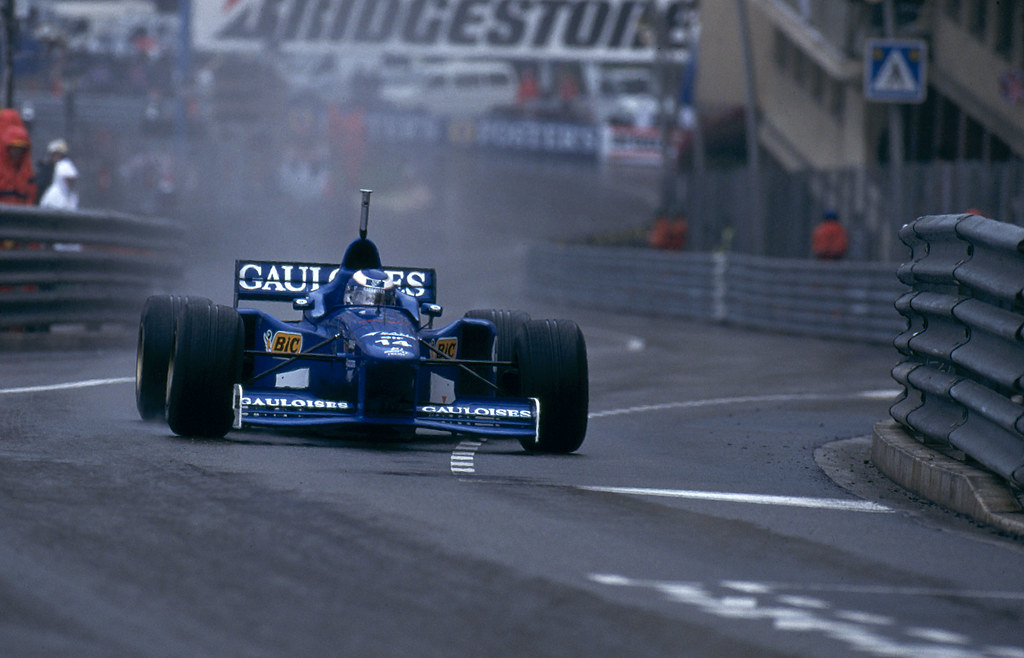The French motorsport team Ligier competed in Formula 1 from 1976 to 1996. Founded by former rugby player Guy Ligier in 1968 initially as a sports car manufacturer, Ligier F1 team became a reality by acquiring the assets of the Matra team in 1976.
Early Days and First Win
Ligier made its Formula One debut in 1976 with French driver Jacques Laffite at the wheel of the Matra V12-powered JS5. While the results were modest in the first season, Laffite secured the team’s maiden pole position at the 1976 Italian Grand Prix. The following year, Laffite piloted the improved JS7 to Ligier’s first ever Formula One victory at the 1977 Swedish Grand Prix, marking the first all-French victory with a French driver, car and engine.
Switch to Ford Cosworth Engines
In 1979, Ligier expanded to two cars and switched from Matra to Ford Cosworth engines. Patrick Depailler joined Jacques Laffite to drive the new JS11, which proved to be highly competitive. Laffite won the opening two races of the 1979 season in Argentina and Brazil, while Depailler took victory at the Spanish Grand Prix. However, despite the early promise, Ligier was unable to maintain their title challenge as other teams developed their cars further through the season.
Golden Era with JS11/15
The 1980 season marked Ligier’s most successful year in Formula One. With Didier Pironi joining Laffite, the upgraded JS11/15 was race-winning straight out of the box. Pironi took an emphatic win in Belgium, while Laffite triumphed on home soil in Germany. The team finished a superb second in the Constructors’ Championship behind Williams.
Matra Engine Supply
From 1981 to 1982, Ligier used Matra V12 engines with backing from Talbot. Jacques Laffite scored two race wins in 1981 to finish a creditable fourth in the Drivers’ Championship. However, 1982 proved difficult as innovative designs from other teams left Ligier trailing the frontrunners. A switch back to Ford Cosworth power for 1983 yielded no success either.
Turbo Era and Renault Partnership
In 1984, Ligier secured a supply of turbocharged Renault engines which marked the team’s entry into Formula One’s infamous turbo era. This came at an opportune time as most competitors were making the switch to forced induction. With Andrea de Cesaris and François Hesnault signed to drive the new JS23, podium finishes proved elusive but the foundations for future success were laid.
The Renault partnership blossomed in 1985 and 1986, aided by the return of team stalwart Jacques Laffite. The experienced Frenchman scored several podiums alongside the mercurial de Cesaris, with Ligier finishing sixth in the Constructors’ Championship in 1985. Further progress followed in 1986 with Renault refugee René Arnoux joining Laffite, before a succession of driver changes after Laffite broke both legs at Brands Hatch.
Struggles without Renault
When Renault withdrew from Formula One at the end of 1986, Ligier lost its works engine supply which sparked the beginning of a sharp decline. Over the next several seasons, a combination of underpowered customer engines and driver instability hampered performance severely. Aside from lone points finishes in 1987 and 1989, Ligier failed to score at all from 1988 to 1991.
There were brief glimpses of hope such as third places for René Arnoux and Olivier Grouillard in 1989 and Nicola Larini’s combative drives in the chronically underfunded 1990 car. But these results only served to underline the team’s overall lack of competitiveness during this difficult transitional period for the sport.
Return of Renault and Sporadic Success
The 1992 season signaled a turning point as Ligier renewed its engine partnership with Renault. While still short of top level pace, improved reliability and racecraft from drivers Thierry Boutsen and Erik Comas yielded several points finishes. Further progress followed in 1993 after an intensive development program over the winter.
Britons Martin Brundle and Mark Blundell scored multiple podium finishes in the JS39, culminating in a superb fifth place for Ligier in the Constructors’ Championship. The team consolidated this momentum with another double podium for Eric Bernard and Olivier Panis at the 1994 German Grand Prix.
Mugen-Honda Power and Monaco Glory
An influx of new investment in 1994 and 1995 resulted in Ligier switching to Mugen-Honda engines. Reliability issues aside, the Japanese V10 engines provided increased power which led to improved qualifying pace. This was exemplified by Panis who stuck his Ligier third on the grid for the 1995 Belgian Grand Prix.
The undoubted highlight came at the chaos-filled 1996 Monaco Grand Prix. Panis drove a measured race in wet conditions, avoided incidents triggered by other drivers, and found himself leading in the closing stages. He held off David Coulthard to take an immensely popular win in Ligier’s final season. It was a fitting swansong for the French team after over 300 Grand Prix entries.

Ligier In F1 History Books
While Ligier may not have consistently challenged for championships, its longevity in Formula One during a turbulent era was no mean feat. As the premier French team during the 1980s and 90s, Ligier carried the hopes of a proud nation on its shoulders while operating on a comparatively modest budget.
Ultimately sold to Alain Prost at the end of 1996 to make way for the Prost Grand Prix team, Ligier demonstrated that success in Formula One requires not just raw talent, but dogged determination in the face of adversity. The team’s fighting spirit lives on through the current Alpine F1 Team as France’s de facto national team at the pinnacle of motorsport.

